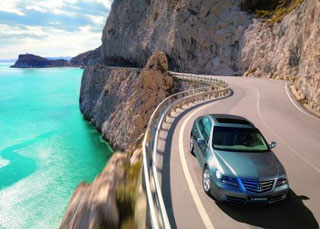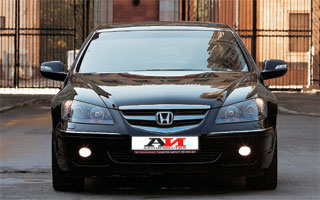Test drive Honda Legend sedan since 2006 sedan
Honda Legend 3.5. From 1,760,000 rubles.
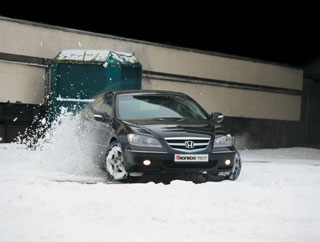 Honda Legend 3.5. From 1,760,000 rubles.
Honda Legend 3.5. From 1,760,000 rubles. The engineers of the Japanese Honda managed to find the middle ground. They created a comfortable sedan, which, if necessary, turns into a large sports car
The appearance of the Honda Legend sedan, which claims to be involved in the premium segment, aroused considerable interest. In appearance, sports roots are guessed. It is worth paying attention to the beveled front racks, an arrow -shaped hood, a smoothed side line. But these are only external attributes. And what is hidden under the hood? A 3.5-liter engine was installed there, from which Japanese engineers removed 295 hp. The novelty accelerates up to 100 km/h for 7.1 s, which is an excellent indicator for a large sedan. Do not forget that the mass of the car is approaching two tons.
For reliable controllability, the car is equipped with a full-wheel drive system with the complex name Sh-Awd (Super Handling All Wheel Drive). This electron-mechanical beast in a split second redistributes the moment on all wheels in such a way that in any road situation the driver can only twist the steering wheel. Of course, all -wheel drive will bring special benefit in winter conditions, when under the wheels it is snow or ice, and in some places dry asphalt.
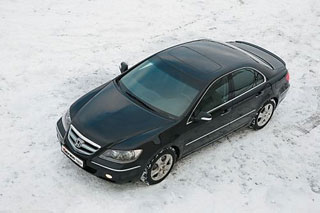 Comfortable chairs with reasonable side support, which does not allow flying along the cabin during active piloting, deserve praise. The materials of the finish also do not cause complaints, but it will not be immediately possible to figure out the interface immediately. The abundance of buttons and all kinds of menu complicates the task, although patience and work will grind everything. A long test showed that Honda Legend is a very comfortable car that, if necessary, turns into a real athlete.
Comfortable chairs with reasonable side support, which does not allow flying along the cabin during active piloting, deserve praise. The materials of the finish also do not cause complaints, but it will not be immediately possible to figure out the interface immediately. The abundance of buttons and all kinds of menu complicates the task, although patience and work will grind everything. A long test showed that Honda Legend is a very comfortable car that, if necessary, turns into a real athlete. Separately, it is worth highlighting the fuel efficiency, which is one of the components of comfort. Gasoline consumption ranges from 12-15 liters. It remains to regret only one thing: the representative sedan is sold in one single configuration. Take what is there, and no options.
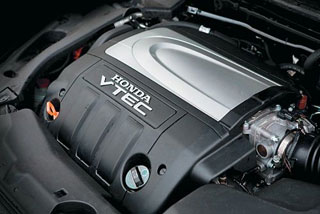 Sh-AWD
Sh-AWD The SH-AWD all-wheel drive system allows you to increase the stability and maneuverability of the car due to the distribution of torque between the front and rear bridges, as well as between the wheels on the rear axle. The percentage of the torque between the bridges is 30:70. Between the wheels it can reach 100: 0. On a heterogeneous coating, the distribution of the moment occurs depending on the degree of adhesion of the wheels with the road. A complex system monitors many parameters: the angle of rotation of the steering wheel, the speed of the wheel, lateral acceleration. As a result, the overall picture of the movement of the car is evaluated. Depending on whether it is a straightforward movement or turn, the SH-AWD system redistributes the moment in the optimal ratio.
Driving
The SH-AWD all-wheel drive system allows you to control the car in any road conditions.
Salon
Spacious salon. Good decoration materials.
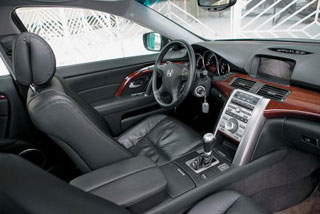 Comfort
Comfort Spacious salon, comfortable chairs, high -quality finishes and moderately hard suspension.
Safety
Legend received the highest ball for protecting adult passengers, four for protecting children and three for protecting pedestrians according to the EURONCAP system.
Price
The price, in comparison with competitors, can be considered overstated.
Advantages and disadvantages
+ Predictable handling, effective brakes, comfortable interior.
- Small trunk, high loading level, complex interface.
Specifications
Mark and Models - Honda Legend 3.5
Dimensions - 4955x1845x1450 mm
Engine - gasoline, 3471 cm3, 295 hp/6200 min -1
The transmission is automatic
Dynamics - 250 km/h; 7.3 s to 100 km/h
Competitors - Volvo S80, Audi A6, BMW 5 -Series, Infiniti M35
Author: Kirill Kozyrev
Photo: Sergey Krestov
Source: Magazine 5 wheel [August 2008]
Honda Legend Crash Test Video since 2006
Honda Legend Sedan test drive since 2006
Honda Legend Sedan Crash Test since 2006
Krassh Test: Detailed Information33%
Driver and passengers
22%
Pedestrians
40%
Children-passengers







